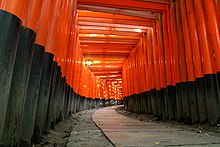Fushimi Inari-taisha
The Fushimi Inari-Taisha (jap. 伏見稲荷大社, also known as Oinari-san) is a Shintō shrine in the Fushimi district of the city of Kyōto.
Dedicated to the kami Inari, it is the main shrine of about a third of all Inari shrines in Japan. It is one of the oldest and most famous Shintō shrines in Kyōto. In addition, it also has the most visitors of all Shintō shrines in Japan, especially on New Year's Day (cf. Hatsumōde) and on uma no hi in February, the Japanese Day of the Horse, on which the shrine has hosted the Hatsu-uma-matsuri - celebrated by all Inari shrines - since 708. In the Fushimi Inari-Taisha, however, it is called Hatsu-uma-tai-sha and lasts a full 21 days.
Particularly famous are the avenues of thousands of orange torii on the grounds of the Fushimi Inari-Taisha, all of which are donations from individuals, families, or businesses. They lead up a hill, at the top of which, unusually for a Shintō shrine, the holy of holies (in this case a mirror) is open to public view.
The Fushimi Inari-Taisha is one of the few shrines (called tanritsu-jinja) that did not join the newly formed umbrella organization Jinja Honchō ("Association of Shintō Shrines") after the end of the war.
·
Entry Torii
· 
Cemetery at the Fushimi Inari-Taisha
· 
The main hall (honden)
· 
Crowds of believers on the shrine grounds

One of the torii ways, interior view
Legends
The hills on which the shrine is located are said to have once belonged to a man named Kadata-ryūtoda ("Dragon Head"). After his death, he is said to have ascended to heaven. The earthly site where this ascension began is a shrine in the Fushimi Inari-Taisha and is protected by a fence.
From the beginning of historiography in Japan, the hills belonged to the powerful Hata clan. According to legend, in 711 one of the clan, a man named Hata-no-irogu (also Hata-no-chōja-irogu), once found some o-mochi (steamed rice cakes) while hunting, hung one of them on a tree and pierced it with one of his arrows. Thereupon the cake is said to have turned into a swan (hakuchō) and flown away. Since that day, the power of the rival Kada clan is said to have steadily declined.
Full of remorse, Hata-no-irogu is said to have gone in search of the swan and found it on the summit of the Sangamine peak of Mount Inari. There he then began his worship of the kami Uka-no-mitama (under the name Uka-no-mitama-no-ōkami, 宇迦之御魂大神), Saruda-hiko (under the name Sada-hiko-no-ōkami, 佐田彦大神) and Ame-no-uzume (under the name Ō-miya-no-me-no-ōkami, 大宮能売大神). This is said to have given rise to the Fushimi Inari-Taisha, which soon received imperial support. Hata-no-irogu was appointed its first chief priest. The rest of the clergy was recruited from members of the Hata and Kada clans, whose ancestors are also venerated in side shrines.
Kami and shrines
These three kami Ame-no-uzume, Saruda-hiko (also known there, among others. known by the names Ō-tsuchi-nokami, Sada-hiko, Yachimata-no-kami, Sake-no-kami, and Dōso-jin, among others) and Uka-no-mitama-no-mikoto (according to the Kojiki, a son of Susanoo and Kamu-ō-ichi-hime; according to the Nihongi, however, a son of Izanami and Izanagi) are, according to the tradition of this legend, worshipped in the Fushimi Inari-Taisha as Inari, which they together constitute. They are nevertheless worshipped in different shrines on three different hills: Ame-no-uzume on the first peak under the name Ō-miya-hime in the Minami-no-za-no-kami-no-yashiro, Saruda-hiko on the second peak under the name Ō-da-no-mikoto in the Kita-no-za-no-naka-no-yashiro, and Uka-no-mitama on the third peak in the Mannaka-shimo-no-yashiro, where the food kami Ō-ge-tsu-hime-no-kami, said to be one of the last children of Izanami and Izanagi, is also worshipped.
In 1266, two more kami were added to the shrine: Tanaka-no-ōkami (田中大神, "The Great Kami in the Midst of the Rice Field," probably just another name for Inari) and Shi-no-ōkami (四大神), who is said to have founded the legend and cult of Kadata-ryūtoda. Together with the other three, they make up the great kami Inari-go-sha-dai-myōjin or Inari-ō-kami. In 1438, a joint shrine was then dedicated to the first three kami at the foot of the mountain, and in 1821 the additional two kami were given shrines of their own.
A secondary shrine is the Go-za-aiden, a massha for the kami Nyaku-ōji (a name for Fujiwara no Uona (721-783), servant under four Tennō, from Shōmu to Kōnin). In addition, the Ise-no-ryō-gu-sha also exists, in which Amaterasu is worshipped along with Uke-mochi-no-kami (who is said to have supplied Jimmu-tennō's army with food and to have been killed by Tsuki-yomi, according to Nihonshoki).
Questions and Answers
Q: What is Fushimi Inari-taisha?
A: Fushimi Inari-taisha is a large Shinto shrine in Fushimi Kyoto, Japan.
Q: Who is Inari?
A: Inari is the rice god.
Q: Where are Inari shrines located?
A: Inari shrines are located in many parts of Japan.
Q: How many sub-shrines or bunsha are there in Japan?
A: There may be more than 32,000 sub-shrines or bunsha in Japan.
Q: What is the significance of Fushimi Inari-taisha?
A: Fushimi Inari-taisha is the head shrine of Inari, the rice god.
Q: What type of religion is Shinto?
A: Shinto is an indigenous religion of Japan.
Q: What is the significance of rice in Japanese culture?
A: Rice is a staple food in Japanese cuisine and has cultural and religious significance, including associations with fertility, abundance, and the divine.
Search within the encyclopedia
